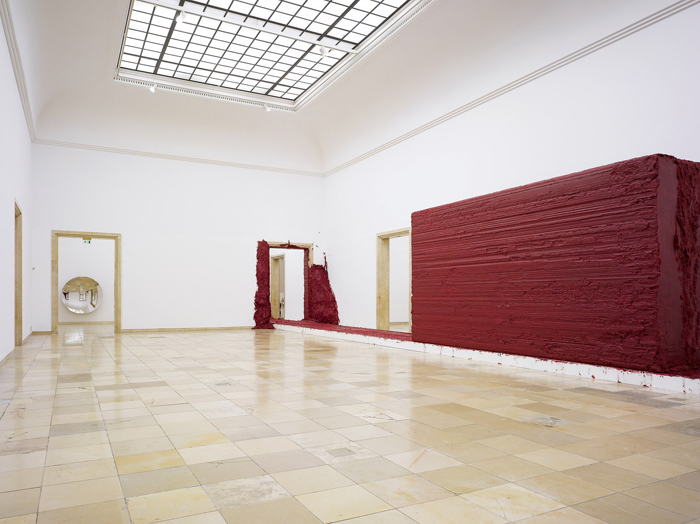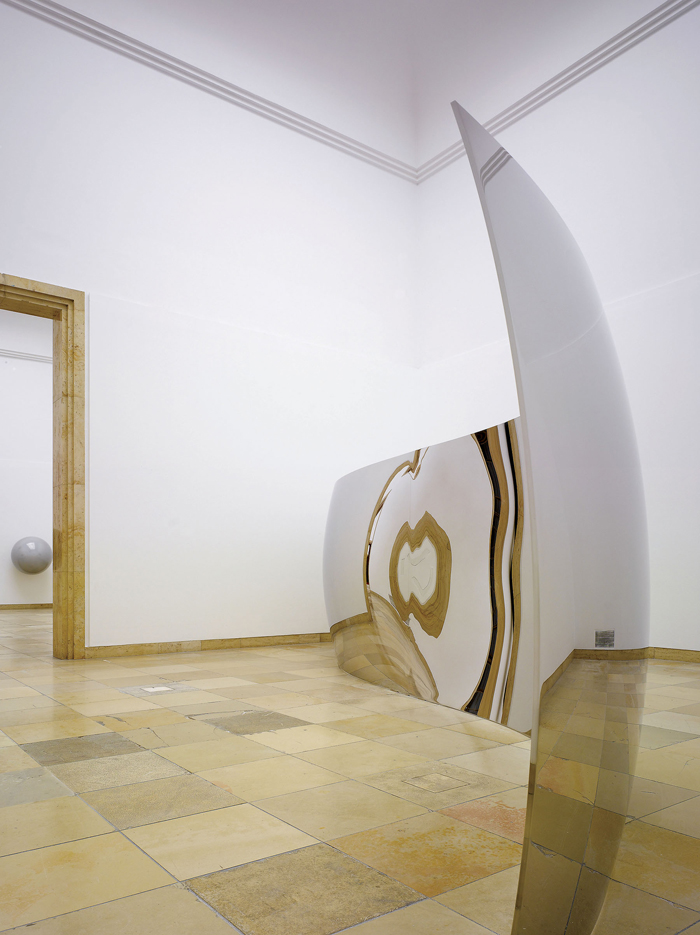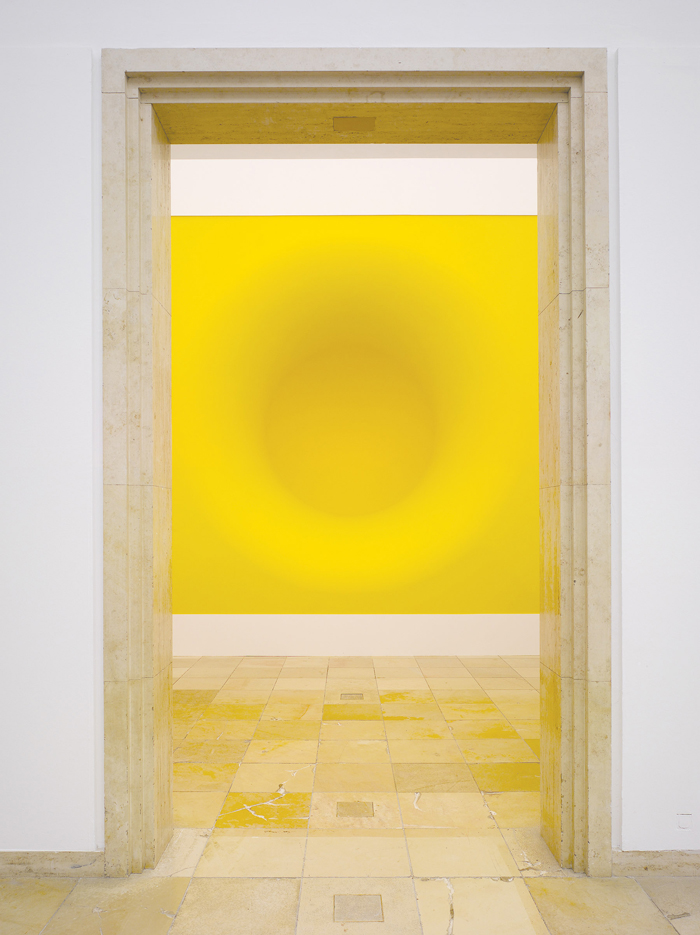In 2007, Anish Kapoor created the installation Svayambh for the Haus der Kunst (House of Art) in Munich, as a response to the building’s imposing architecture and its history.1 In 1937, the Haus der Kunst (the first monumental propaganda building of the Third Reich) opened its doors to the public with “The Great German Art Exhibition,” a show of Nazi-sanctioned art. In 1945, American occupation forces used the Haus der Kunst as their canteen; it then became an exhibition space for artworks left homeless through Allied bombing of the city’s museums. In the mid-1980s, Joseph Beuys’ At the End of the Twentieth Century, an installation of basalt “logs,” clay and felt, brought connotations of regeneration into the building’s interior spaces.2 In the new millennium, the Haus der Kunst has been home to a program of changing exhibitions by contemporary artists.

Anish Kapoor, Svayambh, 2007. Mixed media, dimensions variable. © Jens Weber, Munich.
So much, one might say, for the vagaries of history. Yet history is never a neutral force. At the end of the nineteenth century, Friedrich Nietzsche reminded those enamored of objectivity that history is never innocent—whether crafted or ignored by human agents, or imposed on them, history is made and written by individuals.3 “Think now,” T.S. Eliot implored in Gerontion, a poem written after the First World War. “History has many cunning passages, contrived corridors/And issues, deceives with whispering ambitions,/Guides us by vanities.” Human beings have been seduced by history; they have suffered on account of history’s vanities, and their own. “After such knowledge, what forgiveness?”4
In 1937, not far from the Haus der Kunst’s display of supposedly great German art, “Degenerate Art” was showcased at the University of Munich’s Archaeological Institute.5 The modern German art we now revere was defamed at this exhibition, and in no uncertain terms. This art, presented as so many tainted specimens, was considered by the Nazis to be de-generate, that is, of impure or improper birth. Once the public had been educated in its evils, this art had to be routed out, and so it was. History, in this case, was far from innocent.
The acceptable and the unacceptable, like good and evil, German and Jew, were categorical certainties in Nazi Germany and the estimation of these categories determined the fate of history—and the lives of millions. If history is made and written by individuals, then the history of Munich’s Haus der Kunst involves generation, degeneration, and regeneration. In this context, Kapoor’s 2007 installation is at home and not at home. Svayambh is an adaptation of svayambhuv, the Sanskrit word for self-generated or auto generated. Svayambhuv, a “‘self-born’ aesthetic,” is distinct from rupa, the human-made form “imposed through human artifice.”6 Kapoor notes the paradox in this “very old aspect of Indian thinking” that claims “there are certain kinds of objects that are self-manifest: they make themselves. These objects are made—but their mythology is that they are not made.”7 Akin to svayambhuv, Kapoor’s sculptures are made by the artist yet they appear to be posited in our reality, to be self-generated—not made but simply there.
Kapoor describes his artistic practice as “drawing in towards a depth that marks and makes a new surface, that keeps open the whole issue of the surface, of surface tension.”8 He calls this depth the void. According to the artist, his artworks are not objects but voids, since the space the artworks contain is “larger than the object that contains it.”9 At their best, the space contained in Kapoor’s voids is apparently limitless. This emptiness—this intimation of space beyond any contained notion of space—is destabilizing for the beholder. Where space and objects in space nest within an understanding of cosmos, of the world or universe as an ordered, harmonious system, emptiness and objects which seemingly contain or otherwise invoke emptiness open out onto an understanding of chaos as a gaping or formless void. Out of chaos, that yawning abyss, notions of the universe, order, harmony and meaning evolve. Kapoor’s interest to create “an object which is not an object, to make a hole in the space, to make something which actually does not exist,”10 charts a movement from cosmos to chaos, from object in space to formless void. This move, played out across the surface of Kapoor’s artworks in the aesthetic experience of them, “keeps open the whole issue of the surface, of surface tension.”

Anish Kapoor, S-Curve II, 2006. Stainless steel, 216.5 x 975.4 x 121.9cm. © Jens Weber, Munich.
In the Haus der Kunst, Kapoor’s voids alter the architectural space by creating their own sense of place. At the same time, they depend on the beholder’s interaction with them. Like icons, their purpose “is to be the support of a contemplation.”11 Two large-scale, polished stainless steel works, S-Curve II (2006) and C-Curve (2007), capture the viewer’s reflection on their surfaces—the reflection of an individual in the Haus der Kunst. In this way, they serve as ground to the figure of the beholder and as the support of his or her contemplation. At one end of S-Curve II, I see a mirror image of myself; at the other, I see myself magnified, reflected from my shoulders down, along with the floor and ceiling window, all of which are distorted into Op shapes which undulate slowly in and out of focus. On the other side, the place of mirror image and magnification are reversed so that now bits of the floor and walls are captured along with me. A quiver of perspectival views array themselves before me as I amble along S-Curve II. Nowhere do these points of view arrange themselves into a view. Any view at all is determined by my presence and desire.
It’s not enough to say that S-Curve II and C-Curve create the illusion of a multitude of perspectives for the beholder. More to the point, these works and others in the installation press on the idea of perspective itself, splintering the idea of a unitary viewpoint into a multitude of viewpoints or, occasionally, into space without a point of view. Emptiness. If the Haus der Kunst was generated from the aspiring ideology of a National Socialist “Thousand Year Reich,” a house erected on a totalitarian certainty, then S-Curve II functions as one of Kapoor’s “One Thousand Names,” as a sculpture which has a thousand possible names.12 It is the beholder who grants a meaning to the “One Thousand Names,” since these sculptures, left to themselves, are void of specific meaning.
The sculptures Kapoor calls “One Thousand Names” demonstrate that content does not equal meaning. Meaningless content might be meaningful, if one succumbs to the invitation to contemplate the void where meaning should be. Historically speaking, and the Haus der Kunst speaks in amplified tones, the shattering of perspective that these works elicit is only salutary. In the words of the philosopher Simone Weil, like Eliot a European who was deeply affected by the wars of European nations, “Whatever is real enough to allow of superposed interpretations is innocent and good.”13

Anish Kapoor, Yellow, 1999. Fiberglass and paint, 600 x 600 x 300cm. © Jens Weber, Munich.
The reflective voids of S-Curve II and C-Curve have their counterpart in Yellow, a monumental fiberglass and paint sculpture of 1999 mounted on a temporary wall almost as high as the ceiling. Seen from across the room, Yellow hovers at the threshold of a marble doorway. Viewed from close range, it bursts forth, enveloping me in a colored void whose depth is impossible to discern. In this void I am in the presence of the absence of perspective. Yellow is formed of fully saturated pigment, matte in appearance, like congealed powder. Kapoor’s way with paint conceals the structure and weight of the artwork at the same time as it brings it forth.14 Yellow is simple and complex, tangible and intangible, self-born.
The surface tension of Kapoor’s voids is contingent in two senses: surface tension depends on the presence of a viewer to set it in motion, and surface tension is open ended, relative to what the beholder brings to the work and to the illusion of formless void the work invokes. I applaud Kapoor’s reliance on the beholder to make the artwork, and his decision to withhold specific content. In this sense, his works of art are quietly monumental. They are grand rather than grandiose in an artworld saturated with works of “message” that repudiate the viewer—works that appear to exist for their sake alone, or for ours, if only for the sake of imparting their statement.
If Kapoor’s works of art have a message, it is our role in the making, content and meaning of any such message, a message contingent and open-ended. When installed in the Haus der Kunst, this message takes on a particular poignancy, even an urgency, that the artist’s works of art do not otherwise appear to have when installed in more seemingly neutral venues. Here, any solipsism on the beholder’s part, any flights into the void in search of one’s self or an expanding experience or answers to the riddles of the universe, is crosshatched by history’s vanities. This is especially the case in the two works commissioned for the installation, Svayambh and Archaeology and Biology (2007), the latter an approximately 1.5 meter slit—at once vulval and savage—carved directly into the wall.
Svayambh, a red paint, wax, and Vaseline block weighing some ten tons, is the centerpiece of the installation. As it slowly makes a straight line through the exhibition space on submerged rails, it soundlessly breaks through door frames, leaving a blood-red mass in its wake. Initially conjuring up Nazi trains of deportation, Svayambh quickly departs from expected meaning. As I pace the length of the exhibition beside the block, I experience its slow trajectory and its clues of forceful entry without any clear idea of its origin or what lends it force. Svayambh’s imposing presence and slowness draw me in. Again, this work—so straightforwardly referential at first view—depends on the presence of a beholder to set it in motion. As a physical object, Svayambh brings to expression the Haus der Kunst’s history of violence. As a perceptual object, as a work of art I not only see but strive to apprehend, it initiates more intimate and associative connotations: trains of thought; the Chinese notion of the red thread; life’s journey. Such connotations are fictional objects, notions on which we hang meaning, meaning generated from ourselves. Without the aid of such fictional objects, life and its meaning flap in the breeze.
In the nineteenth century, the German Romantic poet Novalis remarked that all philosophy is homesickness.15 In the early twentieth century, Weil explained why “to philosophize is to learn to die.”16 Where Novalis linked the desire to know with the impulse for a certain oneness, Weil showed why the desire to know must be coupled with an endurance of the void. Human beings only escape “from the laws of this world in lightning flashes,” she held. “Instants when everything stands still, instants of pure contemplation, of mental void, of acceptance of the moral void.”17 Kapoor’s artworks support our contemplation by shattering our perspective. In the Haus der Kunst, Svayambh implies that history’s vanities and our own include the cost of categorical certainties.
Karen Lang teaches art history at the University of Southern California.
